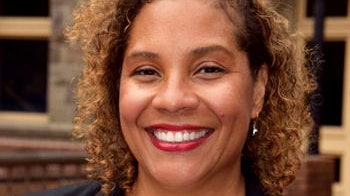It’s not an everyday occurrence when a community college leader gets a phone call telling them their institution will receive an influx of funding in the millions. But such was the case at many two-year schools across the U.S. when MacKenzie Scott, one of the richest women in the world, decided to make a major investment in community colleges.
 Dr. Yoshiko Harden
Dr. Yoshiko Harden
“It’s very unusual, especially in community technical colleges, for a college to just get a sum of what’s basically unrestricted funds to support their mission,” says Dr. Yoshiko Harden, president of Renton Technical College (RTC), which benefited from Scott’s largess.
Since then, the recipient institutions have put their gifts of millions of dollars to use in several ways, seeking to enhance what they offer to the many – and often underprivileged – students that they serve.
Philanthropy and “yielding”
Since 2020, philanthropist and novelist Scott and her team have been doling out gifts and donations totaling in the billions of dollars to hundreds of organizations, after Scott pledged the year before to “give the majority of [her] wealth back to the society that helped generate it, to do it thoughtfully, to get started soon, and to keep at it until the safe is empty.”
According to her philanthropy website, Yield Giving, Scott has gifted more than $16 billion to approximately 1,960 nonprofit groups. A good portion of those donations were given to various kinds of institutions of higher education, many serving students from underserved backgrounds.
The donations made to community colleges were often unrestricted in nature, free for the schools and their leaders to spend as they saw fit, according to community college officials.
“Because we believe that teams with experience on the front lines of challenges will know best how to put the money to good use, we encouraged them to spend it however they choose,” Scott wrote in a June 2021 blog post listing some of the gifts. “Many reported that this trust significantly increased the impact of the gift.
“There is nothing new about amplifying gifts by yielding control,” she continued. “People have been doing it in living rooms and classrooms and workplaces for thousands of years. It empowers receivers by making them feel valued and by unlocking their best solutions.”
In the process of selecting recipients, Scott’s team sought out colleges and universities successfully educating those from chronically underserved communities, she wrote.
As such, several community colleges unexpectedly found themselves better-funded with the money allowing them to aim bigger and reach higher.
Allowing for innovation
Officials from the schools on the receiving end of Scott’s philanthropy have unsurprisingly described their respective gifts as historic. For more than one school, such as Pasadena City College (PCC), it was the largest gift their school has gotten yet.
 Alex Boekelheide
Alex Boekelheide
With the $30 million gift came no advised direction, restrictions, nor stipulations, Boekelheide says, calling Scott’s donation a “windfall” and a “vote of confidence” in what PCC was doing.
After receiving the money in 2021, PCC – like many of the schools – chose to place it in a fund, the proceeds of which the college has been using to finance in-house innova- tion around education and student support.
PCC’s Community Excellence Grants program allows faculty, staff, and students to propose ideas in service of the school, its diverse campus, and its nearby communities. According to the college, the internal grant awards total approximately $1 million a year.
“PCC is a place where we have a lot of creative thinking,” Boekelheide says. “When we have [opportunities and challenges to be addressed] that comes up that way, we want to be able to give folks some ability to engage with those issues and see what they can do to help move us forward. Having this as a resource for that creative thinking has been inspiring and a game-changer at the college.”
Approved proposals came from a wide range of departments and fields and included funding requests for ideas such as nutrition-themed exhibits, a peer leadership and mentorship program for international students, a study abroad program in Hawaii, and a diversity career panel series for students from marginalized communities.
Similarly, Eugenio María de Hostos Community College – a CUNY school in the South Bronx – has been spending some of its $15 million gift from Scott to test new ways to assist its students.
Though the bulk of the gift (about $13 million) was placed in an endowment so that accrued interest can be spent to generally support students, $2 million was assigned to pay for the development of pilot initiatives, says Dr. Sofia Oviedo, research programs director at Hostos.
The initiatives were thought up by a committee involving Hostos faculty, staff, leadership, and alum – it also called for other proposals from the campus community – to then be tested out. The 2023-24 school year saw 12 pilot initiatives implemented, Oviedo says.
Two of the ongoing initiatives were Hostos’s Research Center and its Mentor/Mentee Jobs on Campus program. The former gives disadvantaged students at the community college the chance to take on research project opportunities. And through the latter, students can gain on-campus employment, mentorship from faculty or staff, and job skill development.
 The Student Research and Advocacy Center at Lee College houses a food pantry.
The Student Research and Advocacy Center at Lee College houses a food pantry.
Paying for students
Multiple recipient schools told Diverse that they are using their Scott donations at least partially on scholarship programs. Northeast College’s College Access Scholarship and Renton Technical College’s McCarthy Bridge Grant program are two examples. The scholarship program at Northeast has been in operation since fall 2021 as one of the 384 organizations to receive funding from Scott in December 2020. Its $15 million gift was the school’s largest single donor contribution, according to the school.
Tying eligibility to participation in its TRIO College Success Program, the scholarship program gives each recipient – a first-generation student – $3,000 a year, renewable for up to two years. So far, the program has served 111 students, says Amanda Nipp, Northeast’s vice president of student services.
“For us, it really was this confirmation that we’re doing good work, and we can even do better,” says Northeast President Dr. Leah A. Barrett. “There is growing diversity and there’s a recognition that poverty is a significant challenge that our students face. We were able to get these dollars that have given us this jump-start of moving this work forward to ensure that all of the people in our region have an opportunity for education and workforce development.”
Likewise, Renton Technical College devoted $1.6 million out of its $5 million donation to create its Bridge Grant program, which gives one-time $6,000 grants to 50 students a year, Harden says. The scholarships are meant to help students seeking to transition from high school level and pre-college studies to a credential pursuit at the college.
And Amarillo College in Texas, in addition to spending part of its $15 million unrestricted gift to hire an additional social worker and mental health counselor, used some of the funds to help pay for people to take its short, non-credit “sprint” courses around IT subjects, says Cara Crowley, Amarillo’s vice president of strategic initiatives.
“The city of Amarillo has a really large refugee population,” Crowley says. “So, we’re using the MacKenzie Scott money to help fund stipends for individuals to take these sprints so that they can use those sprints to lead up into academic coursework. They [end] with an industry credential when they complete those series of sprints.”
Student services
Some community college leaders Diverse spoke to said they are spending some of their school’s newfound money toward improving the ways they holistically support students.
Chaffey College spent its $25 million gift partially on programs to invite grade school students to familiarize them with campus and “demystify” higher ed, says Dr. Henry Shannon, Chaffey superintendent and president. The school also bolstered the ways it helps students with health and wellness, including the creation of a farmer’s market where students can access fresh fruits and vegetables.
“Too many billionaires think about empowering the Ivy League or the universities that serve the most elite of folks who really aren’t that much in need,” Shannon says. “Our students are so needy and they’re forgotten. I believe, if you want to serve the most needy folks, it should be given to community colleges.”
Lee College, which received $5 million from Scott, put its money toward renovating its student center, an endeavor that involved the creation of a new Student Resource and Advocacy Center, says Kelli Forde Spiers, Lee’s executive director of student engagement and belonging.
The basic needs hub offers all kinds of assistance, including help with transportation, childcare, and its own market for fresh food, a significant addition because the campus is in a food desert, according to Forde Spiers.
Meanwhile, Kennedy-King College (KKC) put the “lion’s share of [its $5 million] gift” toward its equity initiatives, such as an emergency fund for students in dire financial and unexpected need and an accessibility center for students with learning and physical challenges, says Kennedy-King President Dr. Katonja Webb-Walker.
“We are located in the Englewood neighborhood of Chicago. It’s a community that is really stricken by high levels of poverty, high levels of homelessness, food insecurity, housing insecurity,” Webb-Walker says. “So, many of our students come to us – they’re first-time students, first-generation, working full-time, parenting. ... These funds were set aside to help us to support our students.”
The school is putting forth a deliberate effort to make its campus and facilities more parent-friendly, she says. As part of this plan, KKC will be training its faculty, staff, and administrators to be more responsive to the needs of parenting students.
“Just about half of our students are parenting school-aged children,” Webb-Walker says. “Very often when a KKC student has to make a choice between coming to class or staying home with a sick kid ... We’re trying to figure out what it is we can do on campus so that we’re opening access to drop-in childcare, that we’ve got educational activities for their children while they’re here to register, seek out advising services, or tutoring.”
Back in Texas, Amarillo officials said the school also partnered with a legal aid clinic in thestate to bring a similar oneto campus.
Significance of philanthropy
At times, American higher education gets conflated with only its elite, private institutions instead of the two- and four-year, public institutions “where most Americans are getting their education,” says Dr. Lynn Pasquerella, president of the American Association of Colleges and Universities (AAC&U).
Those kinds of elite schools are no stranger to large endowments. But community colleges are. And a gift like Scott’s can mean a lot to them.
“The gifts have been truly transformative,” Pasquerella says. “Community colleges traditionally haven’t had large endowments. They don’t have graduates who have immediate wealth who can give back in the way that a place like Harvard or Yale might.”
Despite overall giving to U.S. higher ed increasing by 12.5% in the 2022 fiscal year, gifts to two-year colleges saw a decline of 15.4%, according to the Council for Advancement and Support of Education (CASE).
Still, Scott’s gift may yet serve as a catalyst for others to begin giving to their local two-year colleges as well, says Dr. Karen A. Stout, president and CEO of Achieving the Dream.
“To get a significant, unrestricted gift from MacKenzie Scott can really jumpstart a community college private fundraising program,” Stout says. “Often, it’s one significant gift that signals a vote of confidence for others to give to their local community college or even to begin to think about their local community college and their giving plans.”













